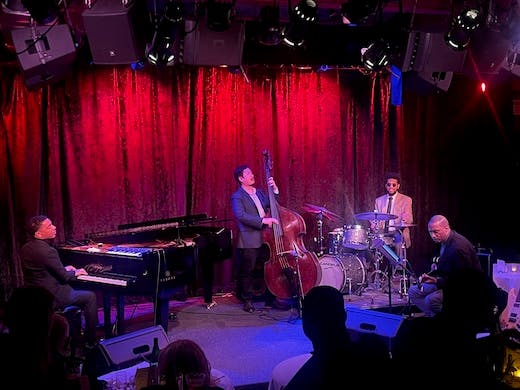Spirituality in the Air as Christian Sands Quartet Plays Birdland
Sands and Marvin Sewell are on a path to becoming a formidable piano-guitar combination, in the tradition of Nat King Cole and Oscar Moore, among others.

Christian Sands Quartet Featuring Marvin Sewell
Birdland
Through March 23
Jazz fans first heard the remarkable pianist Christian Sands about a dozen years ago in a trio led by superstar bassist and bandleader, Christian McBride. The reaction that many had then was that the two should team up with the trumpeter Christian Scott and form a new trio called “The Christian Soldiers,” or possibly add a guitarist to play the music of Charlie Christian.
Alas, since Mr. Scott now works under the name Chief Xian aTunde Adjuah, the possibility of an all-Christian ensemble seems remote. Even so, it’s not mere flippancy to ascribe a great deal of Christian significance to the music of Christian Sands. Now firmly established as a significant bandleader himself, with 10 albums to his credit, Mr. Sands is a player and composer with a great deal of spirituality in his music.
We’ve heard the term soul jazz used to describe a lot of different kinds of music; some use it as a softer term for hard bop; others use it as a less pejorative synonym for smooth jazz. In Mr. Sands’s case, it’s a brand of modern jazz closely related to both gospel music and 1960s-style soul.
Mr. Sands is playing this week at Birdland with bassist Yasushi Nakamura, drummer Ryan Sands — the pianist’s brother — and Marvin Sewell, a storied guitarist coincidentally very much in the tradition of Charlie Christian.
Much of the late set at Birdland on Tuesday, the second of 10 shows, had a decidedly theological spin. Early in the evening, the quartet went into an original that seemed like a variation on the traditional spiritual “Bye and Bye.” Like all the best hymns, it conveyed a message that was hopeful and optimistic.
After playing it, Mr. Sands announced that his inspiration was a decidedly more secular concept, titled “Ain’t That the Same?” He described it as referring to that moment in an argument when both parties realize they’re saying the same thing. Naturally enough, that’s an apt description of the jazz process, in which various members of a group solo on different instruments, effectively saying the same thing in varying ways.
Mr. Sands followed with a more overtly inspirational piece about going through “tough times” and “a voice that guides you back on the path you’re supposed to be on.” Titled “Voice of an Angel,” it was overtly lyrical and meditative; Mr. Sewell, playing in his distinctive single note style, added much to make it seem supremely serene.
They followed with a funky, riffy, soulful piece, full of arpeggios, ostinatos, riffs and vamps, and all that good stuff. It was reminiscent of such Horace Silver soul jazz classics as “Home Cookin’” and thus it seemed perfectly fitting that the title, which he announced at the conclusion, was “MMC,” or “Mama’s Mac and Cheese.” The creator of that mac and cheese, the mother of the Sands brothers, was sitting front row center.
The quartet proceeded to two jazz classics by iconic pianist-composer bandleaders, Dave Brubeck and Thelonious Monk. Brubeck’s “Strange Meadow Lark” comes from the classic “Time Out” album but gets less attention than other tracks on that groundbreaking 1959 set perhaps because it’s in a standard 4/4, rather than some out-of-the-ordinary nutso time signature.
After songs about a love of God and then a love of food — which seems an appropriate priority — it was time for a song of romantic love. Mr. Sands began playing unaccompanied and rubato, with the bass and drums gradually entering, playing arco and with brushes rather than just pouncing in at full force. Mr. Sands tapped into Brubeck’s soulful side, even as Miles Davis and Bill Evans had done with “In Your Own Sweet Way.” Ultimately, he found the innate spirituality in a song that purports to be about birds; I guess His eye is on the sparrow after all.
They concluded with the most basic of all jazz standards, “Blue Monk.” Yet, had he not announced the title beforehand, it would have taken me a moment to recognize it; they buried Monk’s unmistakable tune under layers of melodic embellishment before you might say they gradually released it, or rather they slowly allowed the melody to escape.
Mr. Sewell really shined here — as he did throughout the set. I’ve been hearing him for at least 30 years now, particularly with Cassandra Wilson, and he always impresses, though it’s hard to imagine that he’s now the old-timer in the band.
Together, Messrs. Sands and Sewell are on a path to becoming a formidable piano-guitar combination, in the tradition of Nat King Cole and Oscar Moore, Oscar Peterson and Herb Ellils, or McCoy Tyner and Grant Green.
Extolling the melody, they grew louder and funkier; Mr. Sewell played a blues chorus on his electrified instrument that suggested what Mississippi Delta players achieved by running a knife up and down steel strings. They built to an openly erotic climax, so much so that Mr. Sands must have thought twice about playing it with his mother in the house.

